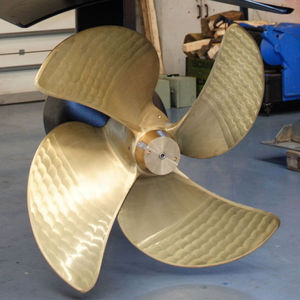

- Products
- Catalogs
- News & Trends
- Exhibitions
Propeller nozzle
Add to favorites
Compare this product
Characteristics
- Options
- propeller
Description
High thrust at low speed
If high thrust at low speeds is important for you, then a nozzle is the best solution. The lifting action of the nozzle profile tends to pull the nozzle forward. How does this work?
On rudder propellers with a nozzle, the velocity of the water flow is increased and the pressure is reduced. As a result, the thrust and the torque of the propeller decreases slightly, while a circulation with inward-directed force takes place. This force provides for a forward-acting element, giving the nozzle a positive thrust which is generally larger than the reduced thrust of the propeller. Due to the small clearance between the nozzle and the tip of the propeller blade, the tip vortices are reduced thereby increasing efficiency. However, the frictional resistance of the nozzle increases as the speed increases, and will eventually become greater than the additional thrust. The nozzle is thus ideal for providing greater pulling power for heavy loads, but less suited for high speed vessels.
The advantages summed up of a nozzle compared to an open propeller:
20 to 25% more thrust at low speeds
The nozzle provides the propeller some protection
Higher "bollard pull"
Air intake at shallow draft can be avoided by placing an anti-vortex plate above the propeller.
Catalogs
No catalogs are available for this product.
See all of VETH PROPULSION‘s catalogsExhibitions
Meet this supplier at the following exhibition(s):

Related Searches
- Thruster
- Propeller
- Electric thruster
- Fixed-pitch propeller
- Propeller shaft propeller
- Transversal thruster
- Built-in thruster
- Bow thruster
- Azimuth thruster
- Tunnel type thruster
- 4-blade propeller
- Ship thruster
- Deck-mounted thruster
- Hydraulic thruster
- Ship monitoring and control panel
- Twin counter-rotating propellers thruster
- Compact thruster
- L-drive thruster
- Ship propeller
- Diesel thruster
*Prices are pre-tax. They exclude delivery charges and customs duties and do not include additional charges for installation or activation options. Prices are indicative only and may vary by country, with changes to the cost of raw materials and exchange rates.


